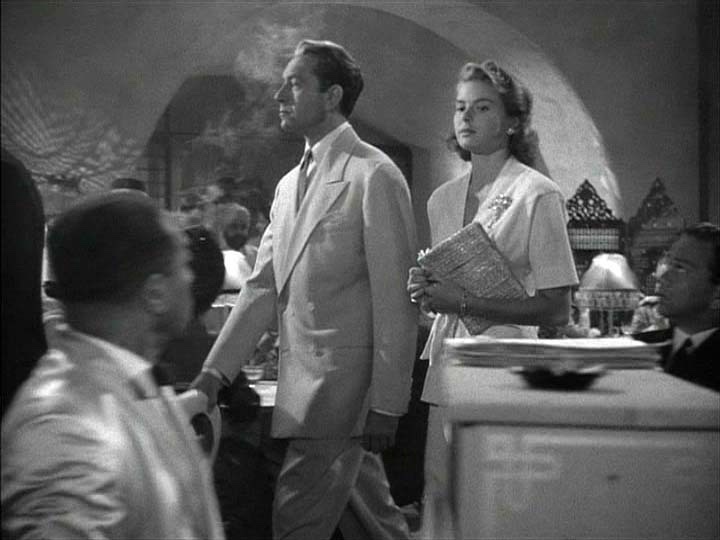Overview:
This scene introduces Victor Lazlo and Ilsa to the film, who enter Rick’s cafe to meet with an ally of Lazlo’s cause. While there, they meet with but are bothered by Captain Renault and the German Major, who interrogates Lazlo and arranges a meeting for the next day. Lazlo stands his ground, but Ilsa is clearly worried for his safety.
Key Elements:
Cinematography –
As Lazlo and Ilsa enter the cafe, the camera tracks their movement, crabbing to the left to keep our focus on them. It does this as hey move through the cafe, coming to rest on Sam to show his concerned reaction to seeing Ilsa, signalling to the audience that there is a connection there. It does this also by showing a closer shot of Ilsa, focusing our attention on her concerned reaction. In close ups of Ilsa, she is in focus whereas the background is only in soft focus, unlike with the other characters, to keep our focus on her and present her as more beautiful.
As with the other sequences, in Classical Hollywood style, the carefully planned camera movements bring the expansive and detailed created set to our attention, immersing us in the environment. It also prevents the need for extensive cutting and distracting the audience from the story and dialogue. The choreography of the actors goes along with the camera movements, keeping everything essential in frame, and moving between different types of shots without much cutting. We see this with how the camera moves up and down as Lazlo is spoken down to by the German Major, and the camera tilts up slightly to keep our focus on Lazlo as he stands up to the oppressive forces against him. When Ilsa and Renault are talking, the scene shot-reverse-shots between them, and when four people are talking in one shot, the face of the person who isn’t, Ilsa, is not shown.
Editing –
Sound –
Editing is kept to a minimum and is all in service of the story in Classical Hollywood Style, but follows typical shot-reverse-shot fashion to show dialogue in a way that makes it digestible, not distracting the audience but directing their attention to what is important in a conversation at a certain moment, such as when Lazlo speaks to the secret resistance member, and it cuts between them to show whoever is talking in the moment.
The diegetic sound of Sam’s piano playing rises in the mix as Lazlo and Ilsa near him, immersing the audience in their position and the environment of Rick’s cafe. When it is more faint in the background, it melts into the rest of the sound mix, keeping the dialogue audible but preventing the scene from becoming silent, keeping the audience immersed in the cafe.
Mise-En-Scen –
Immediately the contrast between Lazlo and Ilsa is set, as Lazlo wears a white suit, but Ilsa wears a white dress which is much lighter and more eye-catching, brining our attention to her. This presents her as elegant, beautiful but more fragile than Lazlo.
Performance –
Lazlo is stoic and almost emotionless compared to Ilsa, who we see tearing up often, with clearly concerned or upset expressions. This presents her as more fragile and innocent than Lazlo, but also intrigues the audience as to her past relationship with Sam and Rick, which she makes clear when she sees them, hears or asks about them. Her accent is also Mid-Atlantic, a fictional accent that was popular in Hollywood at the time to act as a universal accent between American and British.
Context:
Warner Bros. Had a stable of actors which they wanted to exhibit to the audience to make most use of, similarly to the sets they use in this film. In this, the audiences attention is brought to Ilsa by her light dress, attractive presentation and the focus of each close up being on her. She is presented as the famous, glamorous film star that she was in real life.
Representations and Aesthetics:
Ilsa is presented as elegant and graceful, with flattering make up, catchlights to make her eyes more captivating and bring our attention to them, establishing an emotional connection with the audience, a captivating outfit and lighting that brings our attention to her. It makes her seem beautiful, but also more fragile and delicate than the males in the film, who are presented are more gruff and less soft. This also symbolises Ilsa’s innocence in contrast with characters like Lazlo and Rick. It also plays into Warner’s intent to create an interventionist film, portraying Ilsa, symbolically, as the weak, vulnerable and delicate European countries at risk of more aggressive, stronger powers. She is also presented like this to make her look glamorous and beautiful for the cameras, attracting audiences to see the film and boasting Warner Bros.’ Stable of actors.
The Nazi officer is portrayed as self-important, smug, proud, formal and entitled, whereas the French Chief of Police, Renault, is more polite, gracious and informal.
Auteur:

You must be logged in to post a comment.